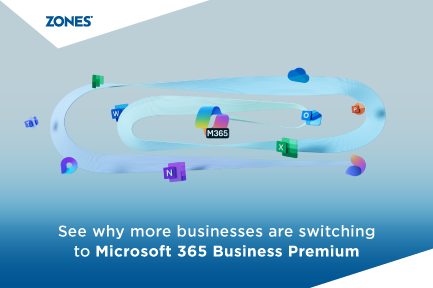Is Your Microsoft 365 Plan Doing Enough to Protect Your Business?
You’ve already invested wisely by choosing Microsoft 365. Your teams rely daily on Outlook, Teams, SharePoint and Office 365 Apps like (Word, Excel,...
3 min read
![]() Zones
:
Aug 21, 2025 10:15:00 AM
Zones
:
Aug 21, 2025 10:15:00 AM

Wireless connectivity is the lifeblood of digital architecture. Without it, our laptops, computers, and IoT devices couldn’t stay connected, transmitting the critical data we use daily to conduct business.
As we move into the sixth and seventh generations of Wi-Fi also known as Wi-Fi 6 and Wi-Fi 7 what do you need to know about the latest evolutions in Wi-Fi technologies and how they can serve your business? In this blog, we’ll examine the benefits and break them into quick, readable chunks.
Wi-Fi 6 is named after the interoperability certification program managed by the Wi-Fi Alliance. The core innovation of Wi-Fi 6 is its Orthogonal Frequency Division Multiple Access (OFDMA) feature. That might sound technical and confusing, but it simply refers to its ability to support more devices on a network.
Wi-Fi 6 introduces a feature called Target Wait Time (TWT). This feature reduces power usage for mobile devices by enabling them to better manage active and sleep power modes. This, in turn, helps end users get more life out of each mobile charge and decreases overall energy use. Aside from merely increasing the number of devices on a network, Wi-Fi 6 also boosts improved network speeds and overall network performance.
If your enterprise is expanding and you’re increasing the number of devices running high-bandwidth, low-latency applications on your network, Wi-Fi 6 is an upgrade to consider. Want to learn if Wi-Fi 6 is right for your business?
Technology is moving fast. In fact, as many businesses consider implementing Wi-Fi 6, Wi-Fi 7 has already arrived. The latest evolution in wireless connectivity, Wi-Fi 7 brings significant improvements that build on the technology of Wi-Fi 6.
The benefits of Wi-Fi 7 range from delivering higher-quality video and gaming to supporting more complex applications like AR and VR. For example, using Wi-Fi 7, a construction company that creates 3D models of builds in the pre-construction phase, could host virtual walkthroughs on AR headsets in their office without disrupting other laptops, phones, and devices on their network.
Wi-Fi 7 also delivers new solutions to congestion and interference for high-density areas where network overlap is prevalent. This solves the common problem of experiencing network issues during high population gatherings like events, conferences, or in highly urban areas. This benefits larger organizations, such as corporations with multi-floor office buildings, and massive venues, such as stadiums and worksites.
However, to take full advantages of the many benefits of Wi-Fi 7, businesses must also upgrade their devices as current routers, access points, smartphones, laptops, and TVs don’t support Wi-Fi 7’s advanced capabilities. This adds additional costs that could outweigh the immediate benefits of upgrading to Wi-Fi 7.
Each year, the business world grows more digital. Organizations are constantly adding new features and devices to support employees in their day-to-day work and help them connect to and win more customers. This includes IoT devices, but also data-rich applications that increase strain on businesses’ networks. Today, laptops and computers must be capable of seamlessly running multiple, high-demand software programs, while phones, tablets, and other smaller devices offer a convenient, portable solution to stay connected and even run certain business applications on the go.
Hybrid and remote work have shifted digital demands, creating new security and connectivity challenges. Adding more new devices, without upgrading your network is like buying more cars without building a larger garage. Businesses must consistently assess their network’s speed, capacity, efficiency, and security, and upgrade it as necessary to suit their evolving needs.
Some businesses may be running on slow, inundated, and unsecure networks, which increases their chances of running into system failure and experiencing unwanted periods of downtime. These businesses should invest in network upgrades to ensure they can keep business running as usual. On the contrary, other businesses may be running on strong, secure networks that fully support their evolving needs and current and future device load. These businesses should invest resources elsewhere and not make the potentially costly mistake of needlessly upgrading to a faster, more expensive network.
Determining your current network’s performance and capacity—and finding gaps or weak points—begins with a thorough assessment. If you’re unsure how your network supports your current and future needs, reach out to our expert networking team to get a full network assessment.
Deciding when to upgrade your business network to Wi-Fi 6 or 7 requires a thoughtful assessment of your current infrastructure, budget, risk tolerance, and evolving device and application needs. Wi-Fi 7 offers the most advanced features on the market, including best-in-class speed and latency. However, it also comes with higher startup costs, including the need to not only upgrade your network, but all the devices you run on it.
Upgrading to Wi-Fi 6, then periodically reassessing your network, might be a smarter, less costly approach. Another common approach involves upgrading only your densest, most high-demand device areas to Wi-Fi 7, then slowly upgrading other areas as time and budget allow. This multi-phase approach allows businesses to spread out the cost and upgrade as needed.

You’ve already invested wisely by choosing Microsoft 365. Your teams rely daily on Outlook, Teams, SharePoint and Office 365 Apps like (Word, Excel,...

In the last two years, we’ve seen businesses everywhere face a lot of challenges. They’ve been through a global pandemic, an economic recession,...

Everyone wants to grow their business. Bringing in new customers, accumulating more revenue, adding new employees to your team, perhaps even building...